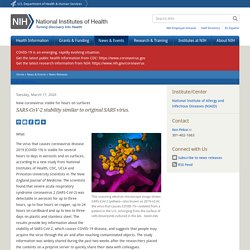

Erinbromage. Please read this link to learn about the author and background to these posts.
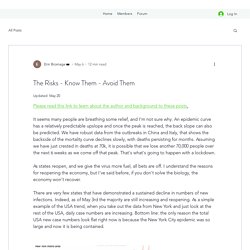
It seems many people are breathing some relief, and I’m not sure why. An epidemic curve has a relatively predictable upslope and once the peak is reached, the back slope can also be predicted. We have robust data from the outbreaks in China and Italy, that shows the backside of the mortality curve declines slowly, with deaths persisting for months.
Assuming we have just crested in deaths at 70k, it is possible that we lose another 70,000 people over the next 6 weeks as we come off that peak. That's what's going to happen with a lockdown. As states reopen, and we give the virus more fuel, all bets are off. There are very few states that have demonstrated a sustained decline in numbers of new infections. (as of May 3rd) So throughout most of the country we are going to add fuel to the viral fire by reopening. COVID 19 Infection prevention and control guidance complete. Evidence based suggestions for the return to elective orthopaedic surgery following the COVID-19 pandemic. By Sarkhell Radhaa,b and Irrum AfzalbaCroydon University Hospital London, UKbSouth West London Elective Orthopaedic Centre, UK Published 01 May 2020 Editor’s note: They say that nature abhors a vacuum so as participants in the natural world we are as guilty as others in wanting to fill one.
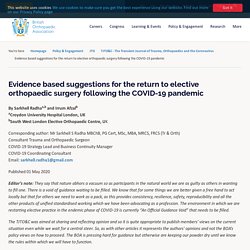
There is a void of guidance waiting to be filled. We know that for some things we are better given a free hand to act locally but that for others we need to work as a pack, as this provides consistency, resilience, safety, reproducibility and all the other products of unified standardised working which we have been advocating as a profession. The environment in which we are restarting elective practice in the endemic phase of COVID-19 is currently “An Official Guidance Void” that needs to be filled. The TJTO&C was aimed at sharing and reflecting opinion and so it is quite appropriate to publish members' views on the current situation even while we wait for a central steer. Abstract Introduction. Ethical PPE use in a Pandemic v0.1 22 04 40. Ethical Use of PPE. COVID-19 - assessing your risk. We know that if you or a loved one are living with a long-term health condition such as arthritis, the information available can be confusing.

We’ve pulled together the latest content from the NHS and worked with the British Rheumatology Society on guidance to help you assess your risk levels, and how best to protect yourself at this time. Assessing your risk – rheumatology patients How high is my risk? ACR COVID 19 Clinical Guidance Summary Patients with Rheumatic Diseases. How to make a non-medical coronavirus face mask – no sewing required. The US Centers for Disease Control now recommends that all Americans wear face masks in public to reduce transmission of Covid-19.
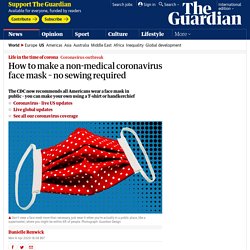
Because there are widespread shortages of medical-grade face masks, and leaders and experts agree those should be reserved for healthcare providers, individuals are largely making face masks at home. Jeremy Howard, a University of San Francisco researcher and the co-founder of Masks 4 All, explains how to create your own, with no sewing required. Version one – the T-shirt facemask: Start with an old T-shirt, preferably 100% cotton – anything will do, as long as it’s not too thin – and outline the pattern of the mask. The bottom line should go just beneath the armpits of the shirt. Version two – the handkerchief face mask: Start with a handkerchief and two hair ties. Using and taking care of your mask: Don’t wear it at home, and don’t wear it in the car, unless you’re with people outside your regular family group. Rheum Immunosuppressants final. Expert Advice on Coronavirus Risk in Immunocompromised Patients With Rheumatic Diseases - Rheumatology Advisor.
Coronavirus disease 2019 (COVID-19) caused by severe acute respiratory syndrome coronavirus 2 (SARS-CoV-2) was characterized as a pandemic by the World Health Organization.1 Among the populations likely to be at higher risk of developing severe infections are patients with rheumatic diseases, including lupus, rheumatoid arthritis (RA), scleroderma, undifferentiated connective tissue disease, and vasculitis.2 Medications for the management of rheumatologic conditions are typically known to be immunosuppressants, making patients more vulnerable to infection with viruses like the coronavirus.
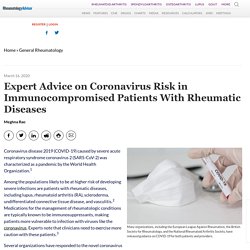
Experts note that clinicians need to exercise more caution with these patients.3 In this interview, we spoke with Douglas Roberts, MD, rheumatologist, Assistant Clinical Professor of Medicine at the University of California, Davis, and Medical Advisor to CreakyJoints, about COVID-19 infection risk and severity and preventive measures for patients who are immunocompromised with rheumatic diseases. 1. 2. DEFINE_ME. As of March 12, 2020, coronavirus disease 2019 (COVID-19) has been confirmed in 125 048 people worldwide, carrying a mortality of approximately 3·7%, WHOCoronavirus disease 2019 (COVID-19)situation report – 52. compared with a mortality rate of less than 1% from influenza.

There is an urgent need for effective treatment. Current focus has been on the development of novel therapeutics, including antivirals and vaccines. No Correlations Between the Development of Specific IgA and IgM Antibodies Against Anti-TNF Blocking Agents, Disease Activity and Adverse Side Reactions in Patients With Rheumatoid Arthritis - PubMed. The use of tumour necrosis factor (TNF) antagonists (infliximab [IFN], etanercept [ETN], adalimumab [ADA]) has changed the course of many rheumatic diseases, including rheumatoid arthritis (RA).
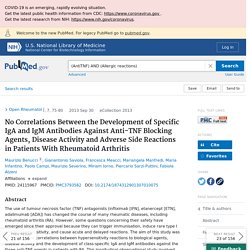
However, some questions concerning their safety have emerged since their approval because they can trigger immunisation, induce rare type I and III hypersensitivity, and cause acute and delayed reactions. The aim of this study was to evaluate the correlations between hypersensitivity reactions to biological agents, disease activity and the development of class-specific IgA and IgM antibodies against the three anti-TNF agents in patients with RA.
The Pharmacokinetics of Biologics: A Primer - PubMed. New coronavirus stable for hours on surfaces. Loading Skip to main content.
